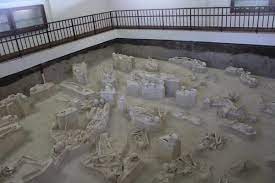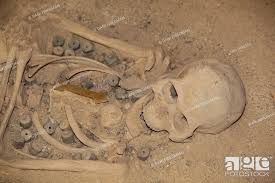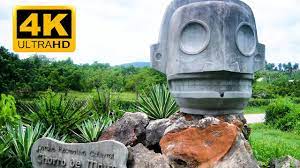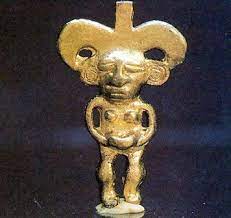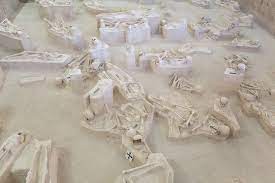“CHORRO DE MAITA”, BANES, CUBA CAPITAL ARQUEOLOGICA DE NUESTRA ISLA. DESCUBRIMIENTOS. PHOTOS.
Cuenta la historia que por el año de 1768 en el holguinero Cerro de Yaguajay, existia una finca cuya propietaria era conocida como Maita. Del mismo centro de aquella parcela brotaba un poderoso surtidor de agua y, desde entonces, los pobladores del sitio comenzaron a identificar la zona como “El Chorro de Maíta”.
Aunque Yaguajay es el nombre aborigen del hermoso paraje de la oriental provincia cubana de Holguín, sus primeros exploradores arqueológicos decidieron referirlo como el popular ‘Chorro de Maíta’. Fue en la década de 1930 cuando llegaron allí los primeros exploradores, buscando elementos que confirmaran la indudable presencia aborigen.
RECIENTES ESTUDIOS ARQUEOLOGICOS..
Recientes estudios arqueológicos practicados en el cementerio aborigen ‘Chorro de Maíta’, han arrojado nuevas teorías en torno a la extinción de los aborígenes cubanos. El sitio, considerado Monumento Nacional, está enclavado en el municipio de Banes, capital arqueológica de Cuba.
El caliche, muy común en Banes, tiene allí un espesor aproximado de un metro con cincuenta centímetros. El caliche es una roca sedimentaria, un cemento natural endurecido de carbonato de calcio que une otros materiales, como grava, arena, arcilla y limo. Ocurre en todo el mundo, en órdenes de suelo aridisoles y mollisoles, generalmente en regiones áridas o semiáridas. El término caliche es español y es originario del latín calx, que significa cal.
Durante las excavaciones saldrían a la luz vasijas, adornos, fragmentos de latón, cascabeles españoles, y serían conocidos los llamados enterramientos cristianos, al parecer practicados por nuestros aborígenes.
Basándose en los aportes de esos estudios, un nuevo equipo de especialistas del Departamento Centro Oriental de Arqueología de Cuba, junto a investigadores de universidades extranjeras, retomaron los estudios en 2005.
Las pesquisas anteriores señalan que en el Chorro de Maíta están presentes todas las formas de enterramiento encontradas no solo en el país, sino en las Antillas y otras zonas del continente. De hecho los arqueologos explican que el “Chorro de Maíta” no es propiamente un cementerio aborigen, sino que en este lugar yacía el camposanto de un pueblo aborigen encomendado.
La encomienda era el sistema a través del cual un grupo de indígenas eran entregados a un español, el cual los obligaba a trabajar a cambio de instrucción religiosa y de un ejemplo de vida que los ayudara a civilizarse.
PRODUCTOS DEL TRABAJO ARQUEOLOGICOS EN EL “CHORRO DE MAITA”..
Durante las excavaciones los investigadores cubanos y extranjeros se adentraron en el apasionante mundo de la arqueología. Desandan el lugar, marcan el terreno y poco a poco empiezan a excavar, poniendo mucho cuidado en cada capa de tierra para no afectar cualquier posible hallazgo. Cada 15 metros van haciendo pequeñas excavaciones, con 40 cm de diámetro. Es un trabajo minucioso y muy agotador, como de artistas.
Así, van apareciendo disímiles objetos, como cerámicas de origen mexicano y español, monedas, corales, azabaches y metales provenientes de Europa. Sin embargo, una idea más ambiciosa los guía: descubrir cuál fue la relación establecida entre aborígenes y españoles, cuya evidencia está contenida en cada uno de esos objetos encontrados y las osamentas de seres humanos que antes se habían estudiado.
Nuevas interrogantes guiaban a los arqueólogos del presente: ¿qué otros misterios guardaría el Chorro de Maíta? ¿Sería posible encontrar otras evidencias que cambiaran las teorías demostradas hasta el presente? ¿Se extinguieron en realidad los indígenas de la zona?
Una respuesta aparecía ante los ojos de los investigadores: ‘Chorro de Maíta’ indicaba la coexistencia de prácticas tanto aborígenes como cristianas en las formas de enterramiento, en una época donde predominaban las encomiendas en Cuba.
Según los expertos arqueologos explican que los agricultores ceramistas no tenían cementerio: tiraban los cuerpos en las cuevas, pero no los enterraban. “En Chorro el cementerio no está ahí porque de pronto decidieron hacer un cementerio y cambiaron su tradición totalmente. Este es el producto de una situación colonial. Allí se han encontrado 133 individuos solamente en la colección excavada. lo cual hace pensar que esta práctica fue impulsada por los españoles, con una concepción cristiana. Por tanto, aquí no había simplemente una aldea aborigen, sino un pueblo encomendado”, afirma el especialista.
NUEVAS CONDICIONES DE COLONIZACION DE NUESTROS ABORIGENES
Entonces, una nueva luz aparecía ante los especialistas: algunos aborígenes aprendieron a convivir en las nuevas condiciones de colonización. “Como Encomendados, mucho de ellos fueron forzados o debieron asumir algunas costumbres de los colonizadores españoles como el vestirse y calzarse, las cuales les permitieron integrarse al nuevo entorno social, por lo que en el genoma del pueblo cubano aún pudieran encontrarse sus trazas. Además, las mujeres aborígenes tenían relaciones con los españoles blancos y nacían niños mestizos, lo cual les daba un nuevo estatus y la posibilidad de mejor alimentación”, segun Valcárcel, uno de los arqueólogos.
Durante la investigación, los especialistas fueron sorprendidos por hallazgos inesperados. Así, encontraron los restos de un africano, una mujer mesoamericana y dos mestizos, los cuales pueden ser los primeros criollos identificados en la región. Con tal descubrimiento, se corrobora la variabilidad étnica, regional y cultural que posee el ‘Chorro de Maíta’.
Pero los estudios, incluían otras sorpresas, pues se confirmó que la tela encontrada en lo que los estudiosos calificaron como “entierro número 57”, era de lino y proviene de una prenda fabricada en Europa o la cuenca del Mediterráneo.
“Gracias al trabajo de Lee Newson, especialista en Paleobotánica de la Universidad de Pensilvania, en Estados Unidos, logramos saber el tipo de tela. Sin embargo, también tiene fibras de plata. Puede que esos hilos de plata están alrededor de los hilos de lino y eso sería tejido de oropel, que es algo que imita al oro y que a veces se hacía con cobre o con oro o con plata.
En cualquier caso, eso nos dice que esa mujer trae encima una tela que no produjeron los indios, sino que fue traída de Europa. Aparentemente también le dieron los objetos de guanín que ella tiene. El guanín es una aleación de oro y cobre, que tampoco se produce en las Antillas”, explica el especialista.
APLICACION DE TECNICAS AVANZADAS…
Esta vez, gracias a la colaboración de instituciones extranjeras de Holanda, Estados Unidos y Noruega, se aplicaron técnicas avanzadas como estudios craneométricos de altísima precisión, estudios de origen, fechados radiocarbónicos, entre otros.
Algunas teorías apuestan por la posibilidad de que los cráneos y esqueletos pertenecieron a personas que vivieron entre 1490 y 1540. Sin embargo, los estimados van mas allá de esos resultados y califican a los hallazgos como el reflejo de la comunidad primitiva residente en el sitio hace unos 10 mil años.
Según explica el prestigioso arqueólogo, José Manuel Guarsh, autor intelectual y guionista de la aldea taína de Chorro de Maíta, las esculturas humanas detallan la deformación craneana, la perfilación del rostro y el rápido envejecimiento de aquel grupo humano que a los 45 años de edad ya era ancianos.
“CHORRO DE MAITA”, BANES, CUBA ARCHAEOLOGICAL CAPITAL OF OUR ISLAND. DISCOVERING’S. PHOTOS.
The story tells that in the year 1768 in the Holguin Cerro de Yaguajay, there was a farm whose owner was known as Maita. From the very center of that plot, a powerful water spout sprouted and, since then, the inhabitants of the site began to identify the area as “El Chorro de Maíta”.
Although Yaguajay is the aboriginal name of the beautiful area in the eastern Cuban province of Holguín, its first archaeological explorers decided to refer to it as the popular ‘Chorro de Maíta’. It was in the 1930s when the first explorers arrived there, looking for elements that would confirm the undoubted aboriginal presence.
RECENT ARCHAEOLOGICAL STUDIES…
Recent archaeological studies carried out in the aboriginal cemetery ‘Chorro de Maíta’, have thrown up new theories regarding the extinction of the Cuban aborigines. The site, considered a National Monument, is located in the municipality of Banes, the archaeological capital of Cuba.
The caliche, very common in Banes, is approximately one meter and fifty centimeters thick there. Caliche is a sedimentary rock, a hardened natural cement of calcium carbonate that binds together other materials, such as gravel, sand, clay, and silt. It occurs worldwide, in soil orders Aridisols and Mollisols, generally in arid or semi-arid regions. The term caliche is Spanish and originates from the Latin calx, which means lime.
During the excavations, vessels, ornaments, brass fragments, Spanish bells would come to light, and the so-called Christian burials would be known, apparently practiced by our aborigines.
Based on the contributions of these studies, a new team of specialists from the Eastern Central Department of Archeology of Cuba, together with researchers from foreign universities, resumed the studies in 2005.
The previous investigations indicate that all the forms of burial found not only in the country but also in the Antilles and other areas of the continent are present in the Chorro de Maíta. In fact, the archaeologists explain that the “Chorro de Maíta” is not exactly an aboriginal cemetery, but rather that the cemetery of an entrusted aboriginal people lays in this place.
The encomienda was the system through which a group of indigenous people was handed over to a Spaniard, who forced them to work in exchange for religious instruction and an example of life that would help them civilize.
ARCHAEOLOGICAL WORK PRODUCTS IN THE “CHORRO DE MAITA”.
During the excavations, Cuban and foreign researchers entered the exciting world of archaeology. They retrace the site, mark the terrain and little by little they begin to dig, taking great care in each layer of the earth so as not to affect any possible find. Every 15 meters they make small excavations, with a diameter of 40 cm. It is a meticulous and very exhausting job, as artists.
Thus, dissimilar objects appear, such as ceramics of Mexican and Spanish origin, coins, corals, jets, and metals from Europe. However, a more ambitious idea guides them: to discover what was the relationship established between aborigines and Spaniards, whose evidence is contained in each of those found objects and the bones of human beings that had previously been studied.
New questions guided the archaeologists of the present: what other mysteries would the Chorro de Maíta hold? Would it be possible to find other evidence that would change the theories demonstrated up to the present? Did the indigenous people of the area really become extinct?
An answer appeared before the eyes of the researchers: ‘Chorro de Maíta’ indicated the coexistence of both aboriginal and Christian practices in the forms of burial, at a time when encomiendas predominated in Cuba.
According to expert archaeologists, they explain that the ceramic farmers did not have a cemetery: they threw the bodies in the caves, but they did not bury them. “In Chorro, the cemetery is not there because they suddenly decided to make a cemetery and totally changed their tradition. This is the product of a colonial situation. There, 133 individuals have been found in the excavated collection alone. which suggests that this practice was promoted by the Spanish, with a Christian conception. Therefore, here there was not simply an aboriginal village, but an entrusted town”, affirms the specialist.
NEW CONDITIONS OF COLONIZATION OF OUR ABORIGINALS
Then, a new light appeared before the specialists: some aborigines learned to coexist in the new conditions of colonization. “As Encomendados, many of them were forced or had to assume some customs of the Spanish colonizers such as dressing and putting on shoes, which allowed them to integrate into the new social environment, so that their traces could still be found in the genome of the Cuban people. In addition, the aboriginal women had relations with the white Spaniards and mestizo children were born, which gave them new status and the possibility of better food”, according to Valcárcel, one of the archaeologists.
During the investigation, the specialists were surprised by unexpected findings. Thus, they found the remains of an African, a Mesoamerican woman, and two mestizos, who may be the first Creoles identified in the region. With such a discovery, the ethnic, regional, and cultural variability that the ‘Chorro de Maíta’ possesses is corroborated.
But the studies included other surprises since it was confirmed that the fabric found in what scholars described as “burial number 57” was linen and came from a garment made in Europe or the Mediterranean basin.
“Thanks to the work of Lee Newson, a Paleobotany specialist at the University of Pennsylvania, in the United States, we were able to determine the type of fabric. However, it also has silver fibers. Maybe those silver threads are around the linen threads and that would be tinsel weaving, which is something that imitates gold and was sometimes made with copper or gold or silver.
In any case, this tells us that this woman is wearing a cloth that the Indians did not produce, but was brought from Europe. Apparently, she was also given the guanín objects that she has. Guanyin is an alloy of gold and copper, which is not produced in the Antilles either”, explains the specialist.
APPLICATION OF ADVANCED TECHNIQUES…
This time, thanks to the collaboration of foreign institutions from the Netherlands, the United States, and Norway, advanced techniques were applied such as high-precision craniometric studies, origin studies, radiocarbon dating, among others.
Some theories support the possibility that the skulls and skeletons belonged to people who lived between 1490 and 1540. However, the estimates go beyond these results and describe the findings as a reflection of the primitive community residing on the site long ago. about 10 thousand years.
As explained by the prestigious archaeologist, José Manuel Guarsh, intellectual author and scriptwriter of the Taíno village of Chorro de Maíta, the human sculptures detail the cranial deformation, the profiling of the face, and the rapid aging of that human group that at 45 years of age he was old.
Agencies/ ChorrodeMaita/ ArqueologicaCubana/ CementeriosAborigenes/ Extractos/ Excerpts/ Internet Photos/ Arnoldo Varona/ www.TheCubanHistory.com
THE CUBAN HISTORY, HOLLYWOOD.





